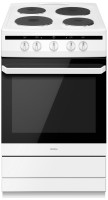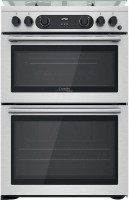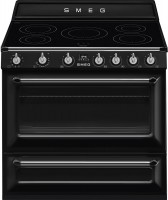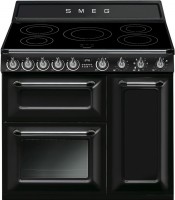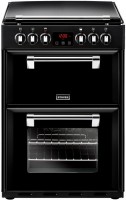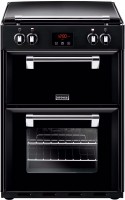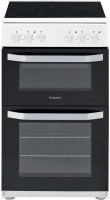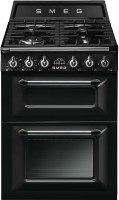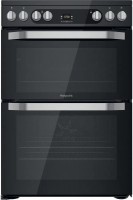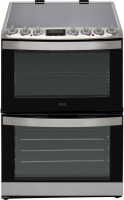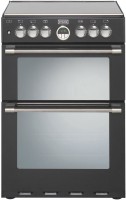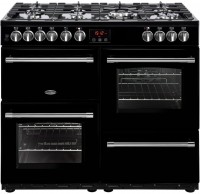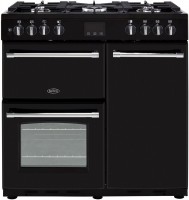Cookers Rangemaster
All Cookers Advanced filters → |
You might be interested in
Articles, reviews, useful tips
All materials
Pyrolysis, catalysis, hydrolysis: what is the most effective method of cleaning an oven?
Let's figure out what catalytic, pyrolytic and hydrolytic oven cleaning are and what are their advantages

Which hob material is better to choose?
All you need to know about hobs, to make operation and maintenance a comfortable experience
Cookers: specifications, types
Show all
Hob type
The type of hob provided in the stove.
The hob is the main working part of the stove, its top part, where the burners are located. The type of such a hob depends on the type of burners:
— Gas. Gas burners are convenient, first of all, with an instant reaction to turning the power regulator knob. In addition, dishes made of any materials and with any shape of the bottom are suitable for them — provided that they normally tolerate heat and stand stably on the grates. In addition, in operation, such stoves are cheaper than electric ones. Their main disadvantage is the need to connect gas. Firstly, gas pipelines are far from being everywhere; and using interchangeable gas cylinders is a rather troublesome business. Secondly, the connection requires carefulness — it must be carried out by a gas specialist. Also, note that gas burners are more demanding on compliance with safety rules than electric ones.
— Electric. Electric hobs are safe and easy to use: there are no open flames that need to be ignited and can go out, causing a gas leak. In such devices, it is easier to implement various additional functions than in gas stoves. In addition, electricity is available in any home, unlike gas. And the connection procedure is quite simple (although it may also require the participation of a specialist). On the other hand, electric hobs have high energy consumption. Therefore, they requir...e high-quality wiring and are more expensive to operate than gas stoves. Another drawback is significant thermal inertia. However, in some advanced types of burners ( Hi-Light, induction — see below), this drawback is minimized. Also, note that all electric burners are demanding on the shape of the dishes: they must have a flat bottom for tight contact with the burner, and induction heaters are also limited in materials.
— Combined. A hob that combines gas and electric burners. The most popular format of such models is “3 + 1”, 3 gas burners and 1 electric. So we are talking about gas stoves, supplemented by an electric burner. The most notable advantage of such hobs is the ability to work even if one of the energy sources is not available. In addition, the combination of different burners allows the user to choose the optimal type of heating for a given situation. At the same time, such versatility is rarely necessary, and when connected, combined hobs combine all the complexities of gas and electric ones: they require gas supply, the participation of a specialist, and high-quality wiring. As a result, there are relatively few such models produced, and they are designed mainly for those who want to have an option in case of problems with gas supply.
The hob is the main working part of the stove, its top part, where the burners are located. The type of such a hob depends on the type of burners:
— Gas. Gas burners are convenient, first of all, with an instant reaction to turning the power regulator knob. In addition, dishes made of any materials and with any shape of the bottom are suitable for them — provided that they normally tolerate heat and stand stably on the grates. In addition, in operation, such stoves are cheaper than electric ones. Their main disadvantage is the need to connect gas. Firstly, gas pipelines are far from being everywhere; and using interchangeable gas cylinders is a rather troublesome business. Secondly, the connection requires carefulness — it must be carried out by a gas specialist. Also, note that gas burners are more demanding on compliance with safety rules than electric ones.
— Electric. Electric hobs are safe and easy to use: there are no open flames that need to be ignited and can go out, causing a gas leak. In such devices, it is easier to implement various additional functions than in gas stoves. In addition, electricity is available in any home, unlike gas. And the connection procedure is quite simple (although it may also require the participation of a specialist). On the other hand, electric hobs have high energy consumption. Therefore, they requir...e high-quality wiring and are more expensive to operate than gas stoves. Another drawback is significant thermal inertia. However, in some advanced types of burners ( Hi-Light, induction — see below), this drawback is minimized. Also, note that all electric burners are demanding on the shape of the dishes: they must have a flat bottom for tight contact with the burner, and induction heaters are also limited in materials.
— Combined. A hob that combines gas and electric burners. The most popular format of such models is “3 + 1”, 3 gas burners and 1 electric. So we are talking about gas stoves, supplemented by an electric burner. The most notable advantage of such hobs is the ability to work even if one of the energy sources is not available. In addition, the combination of different burners allows the user to choose the optimal type of heating for a given situation. At the same time, such versatility is rarely necessary, and when connected, combined hobs combine all the complexities of gas and electric ones: they require gas supply, the participation of a specialist, and high-quality wiring. As a result, there are relatively few such models produced, and they are designed mainly for those who want to have an option in case of problems with gas supply.
Burner controls
Controls that are directly responsible for adjusting the power of the burners. At the same time, other control elements can be provided in the design. For example, rotary knobs are often combined with buttons, to which additional functions are designated.
— Rotary knobs. The traditional, most common option, found in hobs of all types — both gas and electric — and price categories. Rotary knobs are quite convenient and functional while being simple in design and inexpensive.
— Pop out knobs. A variation on the rotary knobs described above, in which the control knobs can be recessed into the control panel. The specific design may be different: in some models, the handle is recessed during operation; in others, it remains recessed until the corresponding burner is in use and pops out from the panel during operation. This design gives the hob a neat appearance, reduces the number of places where dirt can accumulate, and makes the front panel easier to clean. Unlike rotary knobs, pop out knobs are mainly used in electrical models.
— Touch controls. Touch controls are found only in electric hobs. This option has several advantages. First, the touch controls look neat and have no protruding parts, making them easy to clean. Secondly, the control is carried out with light touches and req...uires minimal effort. Thirdly, touch controls give the stove a stylish and technological appearance. On the other hand, such stoves are quite expensive and may be inconvenient for some users who are accustomed to traditional rotary knobs. Therefore, relatively few touch control models are produced. Usually, it is compact hobs for 1 – 2 burners without an oven, where rotary knobs would not be very appropriate.
— Slider. A kind of touch control represented by sensitive tracks. To adjust the heating intensity of the burners or quickly access other settings of the hob, slide your finger along the corresponding touch scale to the selected value. The convenience of slider control also lies in the fact that you can immediately set the required heating power by clicking on a certain area of the scale.
— Push-buttons. Control, carried out exclusively with the help of buttons, is used very rarely in modern stoves. Most models with such controls are compact portable stoves for one or two burners: it is not always convenient to equip such devices with rotary knobs, but the buttons fit well into the design. They are also cheaper than touch controls. On the other hand, the price difference is not so great, and the buttons are somewhat less convenient to use and clean — mainly for this reason they are noticeably less common.
— Rotary knobs. The traditional, most common option, found in hobs of all types — both gas and electric — and price categories. Rotary knobs are quite convenient and functional while being simple in design and inexpensive.
— Pop out knobs. A variation on the rotary knobs described above, in which the control knobs can be recessed into the control panel. The specific design may be different: in some models, the handle is recessed during operation; in others, it remains recessed until the corresponding burner is in use and pops out from the panel during operation. This design gives the hob a neat appearance, reduces the number of places where dirt can accumulate, and makes the front panel easier to clean. Unlike rotary knobs, pop out knobs are mainly used in electrical models.
— Touch controls. Touch controls are found only in electric hobs. This option has several advantages. First, the touch controls look neat and have no protruding parts, making them easy to clean. Secondly, the control is carried out with light touches and req...uires minimal effort. Thirdly, touch controls give the stove a stylish and technological appearance. On the other hand, such stoves are quite expensive and may be inconvenient for some users who are accustomed to traditional rotary knobs. Therefore, relatively few touch control models are produced. Usually, it is compact hobs for 1 – 2 burners without an oven, where rotary knobs would not be very appropriate.
— Slider. A kind of touch control represented by sensitive tracks. To adjust the heating intensity of the burners or quickly access other settings of the hob, slide your finger along the corresponding touch scale to the selected value. The convenience of slider control also lies in the fact that you can immediately set the required heating power by clicking on a certain area of the scale.
— Push-buttons. Control, carried out exclusively with the help of buttons, is used very rarely in modern stoves. Most models with such controls are compact portable stoves for one or two burners: it is not always convenient to equip such devices with rotary knobs, but the buttons fit well into the design. They are also cheaper than touch controls. On the other hand, the price difference is not so great, and the buttons are somewhat less convenient to use and clean — mainly for this reason they are noticeably less common.
Design
The retro design imitates old kitchen appliances. Retro cookers are often equipped with details of an unusual, fanciful shape; brass, bronze and other similar materials are widely used. At the same time, in terms of functionality, such models are quite modern and match the classic-looking cookers. Note that retro design is not cheap, so it makes sense to pay attention to such stoves only if the distinctive appearance is fundamentally important and you are ready to pay extra for it.
Oven type
The type of oven installed in the cooker. Gas and electric ovens have almost all the same features as burners of the same type (see "Burner type"). For example, gas ovens heat up faster, and are cheaper to operate but are difficult to connect. Electric ovens are safer and more versatile but require high-quality wiring and can be more expensive in terms of energy costs.
— Gas. Gas ovens are superior to electric ovens in terms of heating speed, but this heating is not as uniform. It is especially noticeable in inexpensive models. As a result, ovens of this type are poorly suited for cooking delicate dishes sensitive to precise temperature control. In addition, some specific features (such as convection) are not compatible with a gas heater.
— Electric. An electric oven takes longer to warm up than a gas oven, but it has better heating uniformity. In addition, such an oven can have convection, grill and other features that expand its capabilities and make life easier. As a result, this option is recommended to sophisticated cooks and enthusiasts dealing with complex recipes.
Note that gas burners are often combined with an electric oven. This option is considered optimal in terms of convenience and practicality, so it is very popular. But the opposite situation — an electric hob with a gas oven — does not occur at all.
— Gas. Gas ovens are superior to electric ovens in terms of heating speed, but this heating is not as uniform. It is especially noticeable in inexpensive models. As a result, ovens of this type are poorly suited for cooking delicate dishes sensitive to precise temperature control. In addition, some specific features (such as convection) are not compatible with a gas heater.
— Electric. An electric oven takes longer to warm up than a gas oven, but it has better heating uniformity. In addition, such an oven can have convection, grill and other features that expand its capabilities and make life easier. As a result, this option is recommended to sophisticated cooks and enthusiasts dealing with complex recipes.
Note that gas burners are often combined with an electric oven. This option is considered optimal in terms of convenience and practicality, so it is very popular. But the opposite situation — an electric hob with a gas oven — does not occur at all.
Oven capacity
It is the volume of the oven provided in the stove. It s the maximum volume of products that can be placed in it without compromising work efficiency. Accordingly, a larger oven is useful for large volumes of cooking; on the other hand, such a capacity will significantly affect the price and dimensions of the stove.
If you buy a regular household stove with 4 burners and do not plan to cook a lot in the oven, you can not pay much attention to this parameter. The capacity of the oven is usually enough for most simple tasks like cooking a pie or baking chicken. But for more serious tasks, a larger oven may be required. Detailed recommendations on volumes can be found in special sources.
If there is an additional chamber (see below), this paragraph usually indicates only the volume of the main oven.
If you buy a regular household stove with 4 burners and do not plan to cook a lot in the oven, you can not pay much attention to this parameter. The capacity of the oven is usually enough for most simple tasks like cooking a pie or baking chicken. But for more serious tasks, a larger oven may be required. Detailed recommendations on volumes can be found in special sources.
If there is an additional chamber (see below), this paragraph usually indicates only the volume of the main oven.
Minimum temperature
The lowest temperature the oven can provide. Usually, it is in the range of +30 to +50 ˚C. So, for example, the minimum heating temperature at +30 ˚C allows you to defrost products. Models with a minimum of 40 ˚C and 50 ˚C allow you to heat ready meals, heat tableware (before serving), dry rusk, etc.
Max. temperature
The highest temperature that the oven can reach during normal operation. The minimum value in modern models is 230 °C. However, even this low temperature is considered sufficient for most simple dishes. The average indicator can be called 240 – 250 °C. Such heating is provided by most modern ovens. And the most advanced models can heat up to 300 °C or more. Such capabilities will be useful for some specific recipes that require high temperatures.
Power
Rated power of the oven installed in the stove. Specified only for electric ovens (see above). When determining this parameter, the power of all heaters and other devices installed in the oven (grill, convector, motorized spit, etc.) is taken into account; in other words, this item indicates the maximum power consumption.
This data is useful primarily for assessing electricity consumption, as well as the connected load during operation. But only ovens with similar functionality can be compared with each other in terms of power — for example, two models with convection. Otherwise, the comparison may be incorrect.
This data is useful primarily for assessing electricity consumption, as well as the connected load during operation. But only ovens with similar functionality can be compared with each other in terms of power — for example, two models with convection. Otherwise, the comparison may be incorrect.
Additional chamber
The presence of an additional chamber in the design of the plate.
Additional chamber is a second oven with its own heater and independent temperature control. Its presence allows you to cook two different dishes at the same time in the oven. At the same time, in the largest and most advanced stoves, an additional oven may practically not differ in volume from the main one. However, even with small volumes, this feature is expensive.
Additional chamber is a second oven with its own heater and independent temperature control. Its presence allows you to cook two different dishes at the same time in the oven. At the same time, in the largest and most advanced stoves, an additional oven may practically not differ in volume from the main one. However, even with small volumes, this feature is expensive.
Features
— Thermostat — a device for adjusting and maintaining the required temperature in the oven. The presence of a thermostat relieves the user of the need to look after the cooking process. Instead, it is enough to set the thermostat to the desired temperature, and the stove will automatically maintain it.
— Timer. Countdown device: the user sets a certain time, after which an audible signal sounds. The specific functionality of the timer can be different — from the simplest rotary knob with an adjustment accuracy of +/-3 minutes to an electronic unit with a display that can count the time to the second and even turn off the stove at the end of the countdown (see "Auto switch-off"). However, this feature greatly simplifies the life of the user. It is more convenient to set the timer and wait for the signal than to keep track of time by the clock.
— Convection. The convection function provides additional hot air circulation and evenly distributes heat throughout the entire volume of the oven. It is useful for baking.
— Rotisserie fork. It is used for cooking several dishes, particularly shish kebab: products are strung on a rotisserie fork and rotated on it. It ensures consistent heating and baking. Often, the rotisserie fork is combined with a grill (see below), although this is not necessary. Also, this device can be...equipped with a drive from an electric motor for automatic rotation.
— Grill(electric or gas). In this case, the grill is an open heater installed in the oven chamber and designed to cook food due to thermal radiation; it can be used alone or in combination with other oven modes. The grill allows you to fry various foods effectively: for example, you can use it cooking meat with a characteristic crust, brown croutons, fry vegetables, etc. It is healthier than traditional frying.
As for the types of grills, electric grills are the most popular nowadays — they are simple in design, provide even heating, allow you to accurately adjust the mode and use many additional functions (up to automatic cooking programs). Such grills can be found even in gas ovens. But gas devices are used much less frequently: they are considered more economical but more complex in design and less convenient to adjust than electric ones.
— Steam cooking. The ability to use the oven for steam cooking. Cooking is carried out in the main chamber of the oven, and the steam comes from a special reservoir into which water is poured in advance. This method is considered more healthy than traditional cooking or, moreover, frying; often, it turns out to be optimal for people with dietary restrictions.
— Door lock. The safety system blocks the oven door, which can be removed by pressing several keys on the control panel at once or using an inconspicuous lock. This feature is useful in families with small children.
— Oven lighting. It is a lamp for lighting the interior of the oven. By turning on such a lamp, you can see the oven insides without opening it and without releasing heat. Yes, even with the lid open, the oven lighting can come in handy — for example, when removing products from a baking sheet (patties, pieces of cookies, etc.) or when cleaning the oven. Note that for the lighting to work, a mains connection is required, even if we are talking about a gas stove.
— Timer. Countdown device: the user sets a certain time, after which an audible signal sounds. The specific functionality of the timer can be different — from the simplest rotary knob with an adjustment accuracy of +/-3 minutes to an electronic unit with a display that can count the time to the second and even turn off the stove at the end of the countdown (see "Auto switch-off"). However, this feature greatly simplifies the life of the user. It is more convenient to set the timer and wait for the signal than to keep track of time by the clock.
— Convection. The convection function provides additional hot air circulation and evenly distributes heat throughout the entire volume of the oven. It is useful for baking.
— Rotisserie fork. It is used for cooking several dishes, particularly shish kebab: products are strung on a rotisserie fork and rotated on it. It ensures consistent heating and baking. Often, the rotisserie fork is combined with a grill (see below), although this is not necessary. Also, this device can be...equipped with a drive from an electric motor for automatic rotation.
— Grill(electric or gas). In this case, the grill is an open heater installed in the oven chamber and designed to cook food due to thermal radiation; it can be used alone or in combination with other oven modes. The grill allows you to fry various foods effectively: for example, you can use it cooking meat with a characteristic crust, brown croutons, fry vegetables, etc. It is healthier than traditional frying.
As for the types of grills, electric grills are the most popular nowadays — they are simple in design, provide even heating, allow you to accurately adjust the mode and use many additional functions (up to automatic cooking programs). Such grills can be found even in gas ovens. But gas devices are used much less frequently: they are considered more economical but more complex in design and less convenient to adjust than electric ones.
— Steam cooking. The ability to use the oven for steam cooking. Cooking is carried out in the main chamber of the oven, and the steam comes from a special reservoir into which water is poured in advance. This method is considered more healthy than traditional cooking or, moreover, frying; often, it turns out to be optimal for people with dietary restrictions.
— Door lock. The safety system blocks the oven door, which can be removed by pressing several keys on the control panel at once or using an inconspicuous lock. This feature is useful in families with small children.
— Oven lighting. It is a lamp for lighting the interior of the oven. By turning on such a lamp, you can see the oven insides without opening it and without releasing heat. Yes, even with the lid open, the oven lighting can come in handy — for example, when removing products from a baking sheet (patties, pieces of cookies, etc.) or when cleaning the oven. Note that for the lighting to work, a mains connection is required, even if we are talking about a gas stove.
Number of cooking modes
It is the number of cooking modes provided in the design of the oven. This item shows the typical cooking modes — for example, “heating”, “heating + convection”, etc. Accordingly, this parameter is highly dependent on additional equipment. However, even in similar models, the number of modes may be different. In general, the more there are, the more opportunities for cooking, and the easier it will be to choose the optimal mode for a specific situation.
Oven cleaning
It is the method of cleaning the inner surface provided in the design of the oven. In addition to traditional and more advanced steam cleaning, there are catalytic and pyrolytic cleaning. More about them:
— Traditional. This option assumes the absence of any devices that facilitate cleaning: you have to wash the oven manually, using ordinary detergents and cleaning products. Such a procedure can be quite troublesome and time-consuming, but such ovens are much cheaper than similar models with more advanced types of cleaning.
— Pyrolytic. Cleaning with high temperature. Dirt on the interior surfaces of the oven is burned to ash, which can then be easily removed without using detergents. At the same time, pyrolytic cleaning equally effectively handles all types of dirt, both new and old. The disadvantages of such a system are the duration of cleaning (sometimes up to several hours), high cost, and significant consumption of resources (electricity or gas, depending on the type of oven). In addition, during the operation of the cleaning system, unpleasant odours often arise, generated by the combustion of contaminants in the oven.
— Catalytic. Ovens with this type of cleaning have a special coating on the inner surface that breaks down grease on the oven walls. Fat disintegration is accelerated at high temperatures; the oven is thus self-cleaning t...o a certain extent. However, the efficiency of catalytic cleaning is lower than that of pyrolytic cleaning. It is unable to cope with the entire amount of fat on the walls. Therefore, such an oven should be washed from time to time. On the other hand, ovens with catalytic cleaning are cheaper than ones with pyrolytic cleaning. And the cleaning itself does not require additional electricity/gas costs, nor is time-consuming (except for washing/wiping).
— Steam cleaning. Cleaning the oven with heated steam. A certain volume of water is poured into a baking sheet or another container, the container is placed in the oven and the cleaning mode is turned on. Due to heating, the water evaporates, and the heated steam softens the dirt on the walls and partially disintegrates the fat. After the end of the programme, it is enough to wipe the oven with a damp cloth. Such a cleaning requires less time and resources than pyrolysis and often turns out to be more effective than catalytic — steam can soften even old dried-up contaminants. At the same time, these ovens are relatively inexpensive. At the same time, this mode does not guarantee to cope with any contamination. It is possible that after the end of the steam cleaning, the oven will have to be washed traditionally.
— Traditional. This option assumes the absence of any devices that facilitate cleaning: you have to wash the oven manually, using ordinary detergents and cleaning products. Such a procedure can be quite troublesome and time-consuming, but such ovens are much cheaper than similar models with more advanced types of cleaning.
— Pyrolytic. Cleaning with high temperature. Dirt on the interior surfaces of the oven is burned to ash, which can then be easily removed without using detergents. At the same time, pyrolytic cleaning equally effectively handles all types of dirt, both new and old. The disadvantages of such a system are the duration of cleaning (sometimes up to several hours), high cost, and significant consumption of resources (electricity or gas, depending on the type of oven). In addition, during the operation of the cleaning system, unpleasant odours often arise, generated by the combustion of contaminants in the oven.
— Catalytic. Ovens with this type of cleaning have a special coating on the inner surface that breaks down grease on the oven walls. Fat disintegration is accelerated at high temperatures; the oven is thus self-cleaning t...o a certain extent. However, the efficiency of catalytic cleaning is lower than that of pyrolytic cleaning. It is unable to cope with the entire amount of fat on the walls. Therefore, such an oven should be washed from time to time. On the other hand, ovens with catalytic cleaning are cheaper than ones with pyrolytic cleaning. And the cleaning itself does not require additional electricity/gas costs, nor is time-consuming (except for washing/wiping).
— Steam cleaning. Cleaning the oven with heated steam. A certain volume of water is poured into a baking sheet or another container, the container is placed in the oven and the cleaning mode is turned on. Due to heating, the water evaporates, and the heated steam softens the dirt on the walls and partially disintegrates the fat. After the end of the programme, it is enough to wipe the oven with a damp cloth. Such a cleaning requires less time and resources than pyrolysis and often turns out to be more effective than catalytic — steam can soften even old dried-up contaminants. At the same time, these ovens are relatively inexpensive. At the same time, this mode does not guarantee to cope with any contamination. It is possible that after the end of the steam cleaning, the oven will have to be washed traditionally.
Guides
Type of tray guides provided in the oven.
— Frame. The simplest guides are made in the form of a fixed grid, and sometimes in the form of slots in the walls of the oven. They are quite practical and inexpensive, due to which they are used in the vast majority of ovens. The main disadvantage of the lattice guides can be called the fact that the baking sheet moves rather tightly in them, especially if the oven has not been cleaned for some time and the guides are dirty.
— Telescopic. Guides in the form of retractable tray support based on telescopic rails. When removing the baking sheet, the mechanism moves apart, and the stand, rolling on a special roller, “leaves” the oven. The main advantage of the "telescopic rails over the classic frame guides is that you do not need to make much effort to install and remove the baking sheet — it will move very easily. On the other hand, such devices are more expensive and more complicated than classic frame guides; as they get dirty, their efficiency drops noticeably, and dirt can completely disable the mechanism. In light of all this, manufacturers most often use telescopic rails not as the main option but as an addition to the frame guides described above. If telescopic guides are initially indicated in the specs of the stove, this usually means that the oven with traditional frame guides is additionally equipped with removable telescopic guides. These advanced telescopic rails ca...n be easily set at the desired level and removed for cleaning.
Many ovens, initially equipped only with frame guides, can be equipped with telescopic rails, purchased separately.
— Frame. The simplest guides are made in the form of a fixed grid, and sometimes in the form of slots in the walls of the oven. They are quite practical and inexpensive, due to which they are used in the vast majority of ovens. The main disadvantage of the lattice guides can be called the fact that the baking sheet moves rather tightly in them, especially if the oven has not been cleaned for some time and the guides are dirty.
— Telescopic. Guides in the form of retractable tray support based on telescopic rails. When removing the baking sheet, the mechanism moves apart, and the stand, rolling on a special roller, “leaves” the oven. The main advantage of the "telescopic rails over the classic frame guides is that you do not need to make much effort to install and remove the baking sheet — it will move very easily. On the other hand, such devices are more expensive and more complicated than classic frame guides; as they get dirty, their efficiency drops noticeably, and dirt can completely disable the mechanism. In light of all this, manufacturers most often use telescopic rails not as the main option but as an addition to the frame guides described above. If telescopic guides are initially indicated in the specs of the stove, this usually means that the oven with traditional frame guides is additionally equipped with removable telescopic guides. These advanced telescopic rails ca...n be easily set at the desired level and removed for cleaning.
Many ovens, initially equipped only with frame guides, can be equipped with telescopic rails, purchased separately.
Number of glass in door
It is the number of layers of glass installed in the oven door. The larger it is, the less heat goes out, and the less the outer surface heats up. The minimum amount required for effective thermal insulation is 2 glasses, and this option is considered the most popular. Ovens with 3 glasses are noticeably less common, mainly middle and high-end models. The maximum number of glasses is 4; such thermal insulation is the most effective. However, it is not cheap and is used extremely rarely, mainly in top-class stoves.
Door closer
Such a device is responsible for pulling the door when closing and, in some models when opening. The idea is that the user does not need to close/open the door completely — pull it to the right place, and then the door will be "picked up" by the door closer and smoothly brought to a fully open or closed state. Such a system eliminates the risk of leaving the oven not completely closed and prolongs the life span of the device.
Hob material
— Enamel. Enamel coating is inexpensive and relatively easy to clean. In addition, enamel can have different colours, which allows you to give the stoves an original appearance (although the most popular is still the classic white colour). On the other hand, cracks, chips and scratches may appear on such a surface. As a result, such a coating is typical for relatively inexpensive boards.
— Stainless steel. Steel hobs are highly durable and attractive. But, it will take a lot of effort to keep such a stove clean: even slight dirt is noticeable on a steel surface (especially polished). And it is more difficult to clean them than enamel. In addition, such surfaces are somewhat more expensive than enamelled ones, and there are, in fact, two design options for them - matte and polished.
- Glass-ceramic. A material is found predominantly in electric stoves; rarely used in gas models, mainly for aesthetic reasons. The main advantages of glass ceramic are resistance to heat and high permeability to heat and electromagnetic radiation. Schott Ceram and EuroKera, manufacturers of this very glass-ceramic, which manufacturers of household appliances install in their models, were especially successful in this. It allows electric burners (regardless of type) to be placed directly under such a surface. The re...sult is a flat top with no protrusions, making cleaning easier and providing a neat appearance. The main disadvantages of this material are high cost and sensitivity to impacts.
- Tempered glass. A material similar to the glass-ceramics described above: the glass surfaces have an attractive appearance, usually with a glossy finish. Another common feature is the ease of cleaning: most of the contaminants are easily removed. However, this material is not as strong as glass-ceramic: it is much more sensitive to impacts and tolerates heat much worse, which makes it poorly suited for installation above burners. As a result, tempered glass is used mainly in gas stoves, where the burners are located above the work surface and tempered glass heats up relatively weakly. Another category of stoves with such a surface is electric models with induction hobs, where the dishes and not the surface are mainly heated (see below for more details).
— Plastic. Working surface made of special heat-resistant plastic. A rather specific option is found mainly among portable single-burner electric stoves with induction heaters (see below). There are several reasons for this. One of them is that, despite the heat resistance, even fairly advanced plastic does not tolerate heating on gas or a classic electric burner. But with an induction burner, this material works without problems, especially since it is well permeable to electromagnetic radiation. Plastic is cheaper than tempered glass or glass-ceramic, and it also weighs less - the latter is important for a stove that is planned to be moved frequently from place to place. At the same time, all these advantages cannot be called critical. As a result, this option, even in its niche, has not received much popularity.
— Stainless steel. Steel hobs are highly durable and attractive. But, it will take a lot of effort to keep such a stove clean: even slight dirt is noticeable on a steel surface (especially polished). And it is more difficult to clean them than enamel. In addition, such surfaces are somewhat more expensive than enamelled ones, and there are, in fact, two design options for them - matte and polished.
- Glass-ceramic. A material is found predominantly in electric stoves; rarely used in gas models, mainly for aesthetic reasons. The main advantages of glass ceramic are resistance to heat and high permeability to heat and electromagnetic radiation. Schott Ceram and EuroKera, manufacturers of this very glass-ceramic, which manufacturers of household appliances install in their models, were especially successful in this. It allows electric burners (regardless of type) to be placed directly under such a surface. The re...sult is a flat top with no protrusions, making cleaning easier and providing a neat appearance. The main disadvantages of this material are high cost and sensitivity to impacts.
- Tempered glass. A material similar to the glass-ceramics described above: the glass surfaces have an attractive appearance, usually with a glossy finish. Another common feature is the ease of cleaning: most of the contaminants are easily removed. However, this material is not as strong as glass-ceramic: it is much more sensitive to impacts and tolerates heat much worse, which makes it poorly suited for installation above burners. As a result, tempered glass is used mainly in gas stoves, where the burners are located above the work surface and tempered glass heats up relatively weakly. Another category of stoves with such a surface is electric models with induction hobs, where the dishes and not the surface are mainly heated (see below for more details).
— Plastic. Working surface made of special heat-resistant plastic. A rather specific option is found mainly among portable single-burner electric stoves with induction heaters (see below). There are several reasons for this. One of them is that, despite the heat resistance, even fairly advanced plastic does not tolerate heating on gas or a classic electric burner. But with an induction burner, this material works without problems, especially since it is well permeable to electromagnetic radiation. Plastic is cheaper than tempered glass or glass-ceramic, and it also weighs less - the latter is important for a stove that is planned to be moved frequently from place to place. At the same time, all these advantages cannot be called critical. As a result, this option, even in its niche, has not received much popularity.
Number of gas burners
The number of traditional gas burners in the stove design (excluding turbo burners, see below). The classic option for a household stove with an oven (regardless of the type of hob) is 4 burners — it provides good multi-tasking and, at the same time, allows you to keep the dimensions of the device within reasonable limits.
Turbo burners
The number of gas burners in which the flame is located not in one, as in standard burners, but in two (or three) rows — in other words, in the form of two (three) rings, one inside the other. Such burners have more power than traditional single-row ones and heat the bottom of the pan more evenly, which can be especially useful when frying. On the other hand, the need for such a heating mode arises quite rarely, and much more gas is consumed than during the operation of a classic burner. As a result, even in advanced stoves, the number of turbo burners rarely exceeds 1.
Number of solid plates
The number of solid plates in the design of the stove.
Solid plate hobs are the simplest type of electric hobs (see Hob type). Such a burner has the appearance of a "pancake" raised above the hob. The main advantages of such burners are the simplicity of design and low cost. On the other hand, they heat up slowly and have high thermal inertia — they react with a great delay in heating power adjustment. Another disadvantage is that solid plates can deform over time. After 2-3 years such a burner may need to be replaced. As a result, solid plate burners are typical for low-cost electric stoves, as well as, combined models, where the electric heater is a spare. But the variety can include both 1-burner stoves and 2-burner stoves.
Solid plate hobs are the simplest type of electric hobs (see Hob type). Such a burner has the appearance of a "pancake" raised above the hob. The main advantages of such burners are the simplicity of design and low cost. On the other hand, they heat up slowly and have high thermal inertia — they react with a great delay in heating power adjustment. Another disadvantage is that solid plates can deform over time. After 2-3 years such a burner may need to be replaced. As a result, solid plate burners are typical for low-cost electric stoves, as well as, combined models, where the electric heater is a spare. But the variety can include both 1-burner stoves and 2-burner stoves.
Number of spiral burners
The number of spiral burners in the design of the stove.
The basis of such a burner is a sheathed heater of a spiral shape (hence the name). At the same time, unlike the same solid plates, the heater is made open, and the dishes are installed directly on it. The advantages of spiral burners include low weight and a higher heating rate than solid plates. At the same time, such burners do not differ in either high efficiency or heating uniformity. And cleaning the spiral heating element from contamination is a rather troublesome task. As a result, this type of burner is found mainly in compact portable stoves, for which light weight is more important than the disadvantages described.
The basis of such a burner is a sheathed heater of a spiral shape (hence the name). At the same time, unlike the same solid plates, the heater is made open, and the dishes are installed directly on it. The advantages of spiral burners include low weight and a higher heating rate than solid plates. At the same time, such burners do not differ in either high efficiency or heating uniformity. And cleaning the spiral heating element from contamination is a rather troublesome task. As a result, this type of burner is found mainly in compact portable stoves, for which light weight is more important than the disadvantages described.
Number of Hi-Light burners
The number of Hi-Light burners in the stove design.
Hi-Light is an improved kind of electric burner in comparison with the solid plate ones described above (see "Hob type"). In such burners, the tubular heating element is replaced by a thin metal strip, and the working surface is usually made of glass-ceramic (see "Hob material"). Due to this, the heating and cooling rate of such burners is much higher than that of solid plate ones (although it does not reach the instantaneous reaction of gas stoves).
Hi-Light is an improved kind of electric burner in comparison with the solid plate ones described above (see "Hob type"). In such burners, the tubular heating element is replaced by a thin metal strip, and the working surface is usually made of glass-ceramic (see "Hob material"). Due to this, the heating and cooling rate of such burners is much higher than that of solid plate ones (although it does not reach the instantaneous reaction of gas stoves).
Number of induction burners
The number of induction burners in the stove design.
Induction burners work due to electromagnetic radiation, which creates special currents in the bottom of the cookware — these currents provide heating. At the same time, the burners do not heat up — they are heated only by the heat from the dishes, so this type of heater is the safest. Another advantage is that the burners react instantly to a change in heating power — as in gas stoves. On the other hand, induction heaters are quite expensive and have specific requirements for cookware: for effective heating, it must have a thick metal bottom. However, a lot of dishes these days are being produced and created based on the possibility of working with such burners. And the variety of stoves starts with models with 1 burner(portable devices without an oven).
Induction burners work due to electromagnetic radiation, which creates special currents in the bottom of the cookware — these currents provide heating. At the same time, the burners do not heat up — they are heated only by the heat from the dishes, so this type of heater is the safest. Another advantage is that the burners react instantly to a change in heating power — as in gas stoves. On the other hand, induction heaters are quite expensive and have specific requirements for cookware: for effective heating, it must have a thick metal bottom. However, a lot of dishes these days are being produced and created based on the possibility of working with such burners. And the variety of stoves starts with models with 1 burner(portable devices without an oven).
Number of halogen burners
The number of halogen-type burners in the design of the stove.
The design of such burners combines a conventional electric spiral and a halogen lamp — a glass tube with an incandescent filament filled with a special gas. When the burner is turned on (or when the heating intensity is increased), both the coil and the lamp work simultaneously — this ensures very fast heating to the operating temperature. And because halogen burners are usually installed under a glass-ceramic surface (see "Hob material"), they cool down quite quickly (much faster than classic solid plate ones). The main disadvantage of such burners, in addition to the rather high price, is the relatively short service life of halogen lamps.
The design of such burners combines a conventional electric spiral and a halogen lamp — a glass tube with an incandescent filament filled with a special gas. When the burner is turned on (or when the heating intensity is increased), both the coil and the lamp work simultaneously — this ensures very fast heating to the operating temperature. And because halogen burners are usually installed under a glass-ceramic surface (see "Hob material"), they cool down quite quickly (much faster than classic solid plate ones). The main disadvantage of such burners, in addition to the rather high price, is the relatively short service life of halogen lamps.
Adaptive zone (FlexZone)
Special zones on the surface of the hob suggesting the possibility of using dishes of non-standard shapes and sizes. The FlexZone consists of several induction heating zones under a single glass-ceramic substrate, which are activated depending on the size of the cookware. Hobs with an adaptive zone automatically recognize the presence of objects, and the simultaneous use of different types of dishes in this area is also allowed.
Bridge mode
A function that allows you to combine two (or more) adjacent electric burners into one cooking zone. This mode is found in induction hobs, less often in Hi-Light, and is not used in gas hobs. Often the bridge zone looks like one continuous zone of an elongated shape, the individual parts of which can be turned on independently and are individual burners. Anyway, the bridge mode can be useful primarily for working with elongated utensils - for example, oval roasting pots. In addition, the design may provide various additional functions - for example, the ability to set different power settings for different parts of the "bridge" and move the dishes between them depending on the readiness of the dish. At the same time, unlike traditional burners, the heating will turn on automatically according to the presence of dishes on the burner.
Dual-circuit burner
Dual-circuit burners are burners with the possibility of increasing the diameter.
Dual-circuit burners are only electric burners of the Hi-Light type or induction. Such a burner looks like several circles of different diameters with a common centre; each circle corresponds to one of the options for the working diameter that can be selected for the burner. The number of these options is usually 2 or 3. And if there is more than one dual-circuit burner, they may differ in the number of diameters available.
This feature allows you to optimally select the working size of the burner for the diameter of the dishes. This feature should not be confused with the oval dual zone (see below): the oval dual zone gives the burner an elongated shape, and the dual circuit burner remains round regardless of the selected size.
Dual-circuit burners are only electric burners of the Hi-Light type or induction. Such a burner looks like several circles of different diameters with a common centre; each circle corresponds to one of the options for the working diameter that can be selected for the burner. The number of these options is usually 2 or 3. And if there is more than one dual-circuit burner, they may differ in the number of diameters available.
This feature allows you to optimally select the working size of the burner for the diameter of the dishes. This feature should not be confused with the oval dual zone (see below): the oval dual zone gives the burner an elongated shape, and the dual circuit burner remains round regardless of the selected size.
Oval dual zone
The presence of an oval dual zone on the hob. Such a heater is useful for working with appropriate elongated dishes (for example, oval roasting pots). In models with electric heaters (see "Burner type") the desired shape is provided by an additional segment installed close to the burner; the burner in normal mode works like a regular round one, and when the additional segment is connected, it turns into an oval. In gas models, a burner with an oval flame is installed, or two small burners located close to each other.
Residual heat indicator
The residual heat indicator is is used in electric stoves. It allows you to determine the presence of hot burners when the power is off, thus reducing the risk of burning yourself on a burner that has not had time to cool down. In addition, the presence of such an indicator helps to save energy.
Burner power
Rated burner power. This parameter allows you to estimate how much electricity the burner will spend when operating at maximum heating intensity. At the same time, the heat transfer power of different burners can be different, and the actual heating efficiency will also greatly depend on the specs of the dishes. As a result, it hardly makes sense to evaluate the operating capabilities of the stove by the power of the burners. It is quite possible to proceed from the fact that the burner will be enough for a dish of the same diameter.
Burner diameter
The heating power, the performance of the device and the speed of cooking depend on the diameter of the burners. The larger the burner, the more heat dissipation it has. Also, the diameter of the burner allows you to determine what sizes of dishes are suitable for use on the hob. Indeed, for induction models, this value is critical for high-quality heating. Burners can have the following diameter:
- small — about 145 mm, power within 1200 W;
- medium — about 180 mm, power within 1700 W;
- large — about 220 mm and more, power within 2000 W.
Burner grates
It is the material from which the burner grates of the stove are made. This parameter is relevant only for gas burners — electric hobs do not have grates.
— Steel grates. The most common type of grates is steel grates coated with a special heat-resistant enamel. They are quite practical, reliable, have a relatively small weight and neat appearance, and at the same time are inexpensive, due to which they are often found in entry-level and middle-level models. The main disadvantage of steel grates can be called the difficulty in cleaning from adhering contaminants — too intensive cleaning can damage the enamel. In addition, they are less durable than cast iron ones, and under heavy dishes containers, they can deform — as a result, the dishes will not stand stably on the stove, and the grate will most likely have to be replaced.
— Cast iron grates. Cast iron grates is much heavier than steel ones. Moreover, they often look more massive and rough. On the other hand, they are more reliable, durable and stable, can cope even with heavy weights and keep their working shape much longer. In addition, cast iron is easier to clean: although dirt comes off worse than enamel, in extreme situations it is quite possible to use abrasive products without fear of damaging the surface.
— Steel grates. The most common type of grates is steel grates coated with a special heat-resistant enamel. They are quite practical, reliable, have a relatively small weight and neat appearance, and at the same time are inexpensive, due to which they are often found in entry-level and middle-level models. The main disadvantage of steel grates can be called the difficulty in cleaning from adhering contaminants — too intensive cleaning can damage the enamel. In addition, they are less durable than cast iron ones, and under heavy dishes containers, they can deform — as a result, the dishes will not stand stably on the stove, and the grate will most likely have to be replaced.
— Cast iron grates. Cast iron grates is much heavier than steel ones. Moreover, they often look more massive and rough. On the other hand, they are more reliable, durable and stable, can cope even with heavy weights and keep their working shape much longer. In addition, cast iron is easier to clean: although dirt comes off worse than enamel, in extreme situations it is quite possible to use abrasive products without fear of damaging the surface.
Gas control
The type of gas control provided in a stove with a gas hob and/or oven.
Gas control is a safety system for gas stoves that turns off the gas supply when the flame goes out. Such a system can be used only in the stove, only in the oven, or both. The latter option, from a safety point of view, is considered perfect for gas stoves. However, gas control is more important for an oven — it is more difficult to control the presence of a flame in it. But in the hob, this function is not so critical, especially if the stove is constantly under supervision during cooking.
Gas control is a safety system for gas stoves that turns off the gas supply when the flame goes out. Such a system can be used only in the stove, only in the oven, or both. The latter option, from a safety point of view, is considered perfect for gas stoves. However, gas control is more important for an oven — it is more difficult to control the presence of a flame in it. But in the hob, this function is not so critical, especially if the stove is constantly under supervision during cooking.
Auto ignition
The type of auto-ignition provided in the stove.
Auto-ignition systems are used only for gas burners and ovens. They work based on an electric spark, from which the gas ignites, and greatly simplifies the ignition of the stove, eliminating the need for matches, lighters and other sources of fire. Auto ignition can be provided for a hob(hob), for an oven, or both. In all these cases, it is assumed that the ignition is activated automatically when the knob is turned. There is also another option for electric ignition — a special button. Such systems are somewhat simpler and cheaper, while they usually cover all gas heaters available in the stove (therefore, the location is not indicated for push-button electric ignition).
Anyway, the stove requires mains for this function to work.
Auto-ignition systems are used only for gas burners and ovens. They work based on an electric spark, from which the gas ignites, and greatly simplifies the ignition of the stove, eliminating the need for matches, lighters and other sources of fire. Auto ignition can be provided for a hob(hob), for an oven, or both. In all these cases, it is assumed that the ignition is activated automatically when the knob is turned. There is also another option for electric ignition — a special button. Such systems are somewhat simpler and cheaper, while they usually cover all gas heaters available in the stove (therefore, the location is not indicated for push-button electric ignition).
Anyway, the stove requires mains for this function to work.
Child lock
A security measure that allows you to block the controls of the stove. It will be useful in families with small children: when the lock is on, a curious child will not be able to turn on the stove or change settings. To unlock, one needs to perform certain actions, which are easy for an adult and too complex for a child: for example, you need to press two specific buttons simultaneously.
Automatic switch-off
The type of automatic switch-off provided in the design of the stove.
Auto-off can be provided for the hob(hob), for the oven, or for both at once, regardless of whether the hob and oven are gas or electric. This function is implemented through a timer, after which the device turns off.
Auto-off can be provided for the hob(hob), for the oven, or for both at once, regardless of whether the hob and oven are gas or electric. This function is implemented through a timer, after which the device turns off.
Display
A display on the stove control panel. Usually, it is a very simple one-colour display : 3-4 digits plus a few additional characters (for example, a thermometer icon and a clock icon). However, even on such a display, almost all important information related to the stove operation can be displayed: heating temperature, clock, timer settings, and other relevant data. Thus, the display significantly simplifies the management of the stove and makes it more convenient.
For technical reasons, this function is mainly used in electric stoves; there are also gas models with displays, but they are extremely few.
For technical reasons, this function is mainly used in electric stoves; there are also gas models with displays, but they are extremely few.
Dishwasher
Some cookers are equipped with a built-in dishwasher. This saves space in the kitchen since, with the dimensions of a standard stove, the user gets two devices. However, the oven in such stoves is very small, and their cost is much higher than traditional stoves, all other things being equal.
The main specs of the dishwasher are capacity, the number of washing programs, water consumption, energy efficiency class, washing efficiency class and drying class. Let's reveal some of them:
— Place settings. 1 set is a set for one person of the following items: four plates (for salad, for the first course, for the second course, for bread), a cup, a saucer for dessert, and two spoons or forks.
— Water consumption per wash cycle. Machines with a consumption rate of up to 15 litres are considered economical, up to 20 are mediocre. However, in general, all dishwashers spend less water than manual washing.
— The energy efficiency class shows the efficiency of electricity consumption by the machine. Classes are labelled with Latin letters from A (most economical) to C (high power consumption).
— The washing efficiency class shows the average quality of washing. Classes are labelled with Latin letters from A to C; accordingly, class A machines wash dishes to almost perfect cleanliness, while in class C, traces of contamination are allowed on the dishes washed in one cycle.
— The drying efficiency class shows the qua...lity of drying. Classes are labelled with Latin letters from A to C. Class A machines dry the dishes to dryness; for classes, B and C, residues of a few drops are allowed.
The main specs of the dishwasher are capacity, the number of washing programs, water consumption, energy efficiency class, washing efficiency class and drying class. Let's reveal some of them:
— Place settings. 1 set is a set for one person of the following items: four plates (for salad, for the first course, for the second course, for bread), a cup, a saucer for dessert, and two spoons or forks.
— Water consumption per wash cycle. Machines with a consumption rate of up to 15 litres are considered economical, up to 20 are mediocre. However, in general, all dishwashers spend less water than manual washing.
— The energy efficiency class shows the efficiency of electricity consumption by the machine. Classes are labelled with Latin letters from A (most economical) to C (high power consumption).
— The washing efficiency class shows the average quality of washing. Classes are labelled with Latin letters from A to C; accordingly, class A machines wash dishes to almost perfect cleanliness, while in class C, traces of contamination are allowed on the dishes washed in one cycle.
— The drying efficiency class shows the qua...lity of drying. Classes are labelled with Latin letters from A to C. Class A machines dry the dishes to dryness; for classes, B and C, residues of a few drops are allowed.
Lid
The lid plays an important role in the design of any stove. Firstly, when open, it protects the wall from dirt and splashed grease during cooking or heating food. And secondly, in the closed position, the lid facilitates cleaning in the kitchen, preventing the possibility of aggressive detergent chemicals getting on the surface of the hob.
— Glass. Glass lids are more aesthetically pleasing. Plus, they are easy to keep clean. The drawback of glass lids is a frequent need to care for the surface of the lid since traces of dirt and stains are clearly visible on it.
— Metal. Metal covers have durability and good resistance to mechanical damage. On the body of the stove, they are fixed by using special hinges.
— Glass. Glass lids are more aesthetically pleasing. Plus, they are easy to keep clean. The drawback of glass lids is a frequent need to care for the surface of the lid since traces of dirt and stains are clearly visible on it.
— Metal. Metal covers have durability and good resistance to mechanical damage. On the body of the stove, they are fixed by using special hinges.
Energy class
The energy class describes the overall efficiency of the cooker in terms of energy consumption. Note that we are not talking about actual consumption (see "Connected load" for details), but about the efficiency of the stove, about the efficiency of using the energy that it consumes.
This indicator is especially important for models with at least one electric burner or electric oven/grill. But, if we are talking about a purely gas stove, you can not pay much attention to the energy consumption class. Electricity in such models is spent only on additional functions like auto-ignition or oven lighting,
Initially, the classes were marked in Latin letters from A(the most economical) and then alphabetically in order of decreasing efficiency — B, C, D ... Later, improved classes A+, A++ appeared; the more pluses, the higher the efficiency. Today, energy consumption in class A can be called medium, and in a lower class — high. The maximum indicator found in modern stoves is A++; if we are talking about a model with an electric burner, such a stove is usually expensive, but it pays off by saving electricity during use.
This indicator is especially important for models with at least one electric burner or electric oven/grill. But, if we are talking about a purely gas stove, you can not pay much attention to the energy consumption class. Electricity in such models is spent only on additional functions like auto-ignition or oven lighting,
Initially, the classes were marked in Latin letters from A(the most economical) and then alphabetically in order of decreasing efficiency — B, C, D ... Later, improved classes A+, A++ appeared; the more pluses, the higher the efficiency. Today, energy consumption in class A can be called medium, and in a lower class — high. The maximum indicator found in modern stoves is A++; if we are talking about a model with an electric burner, such a stove is usually expensive, but it pays off by saving electricity during use.
Connected load
The connected load of the stove is the maximum electrical power consumed during operation. This parameter is indicated only for models that are equipped with at least one electric heater — burner (burners), oven or grill. It is the burners that are the highest consumption in terms of energy consumption; Features such as auto-ignition or oven lighting require little energy, a ordinary socket is enough for them.
First of all, the requirements for the power grid depend on this indicator: it must be able to provide such power without overload. It is worth noting that for household sockets the power limit is about 3 – 3.5 kW; with more power, you need to connect the stove to a 230 V network according to special rules. An alternative is a three-phase 400 V mains: most modern stoves with electric heaters allow connection to both 230 V and 400 V.
First of all, the requirements for the power grid depend on this indicator: it must be able to provide such power without overload. It is worth noting that for household sockets the power limit is about 3 – 3.5 kW; with more power, you need to connect the stove to a 230 V network according to special rules. An alternative is a three-phase 400 V mains: most modern stoves with electric heaters allow connection to both 230 V and 400 V.
Country of origin
The country in which, according to the manufacturer, the model is manufactured. Despite the fact that most of the capacities are concentrated in China, European factories ( in Poland, Slovenia, Romania, Turkey, Czech Republic, etc.) for the production of household appliances have not gone away. And some models can be produced there. In general, such a division into a Chinese or European factory should not particularly affect the quality of products, but the stereotype of a reliable European assembly is present in us. However, it is possible that the model may have a country of manufacture, for example, Poland, and in the store under the same article, you will meet China.

